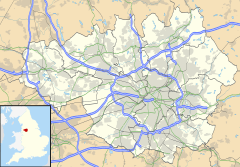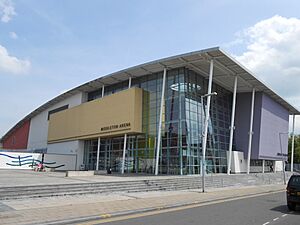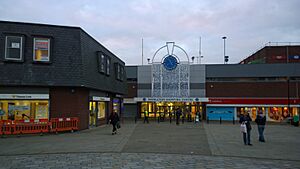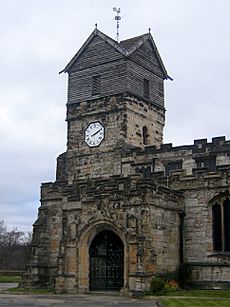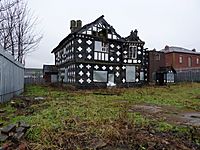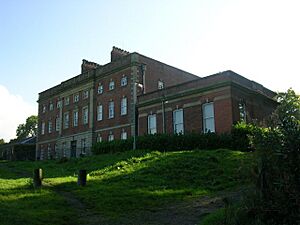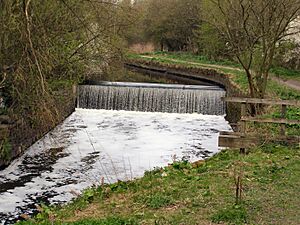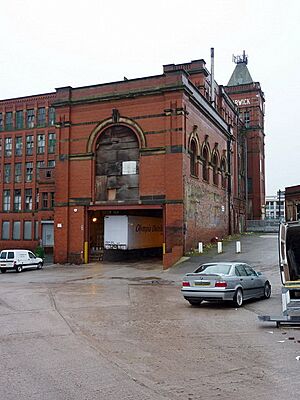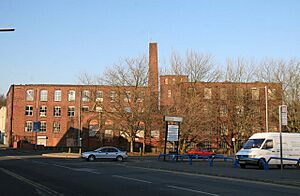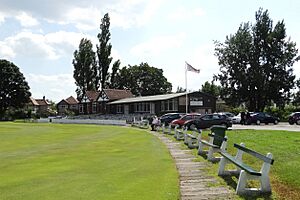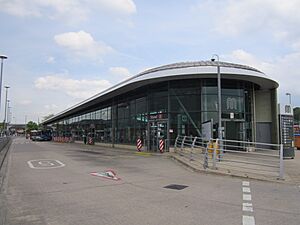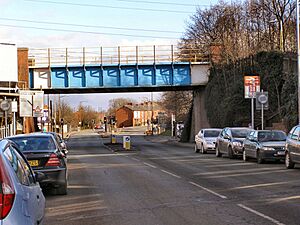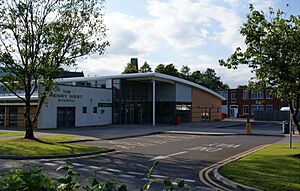Middleton, Greater Manchester facts for kids
Quick facts for kids Middleton |
|
|---|---|
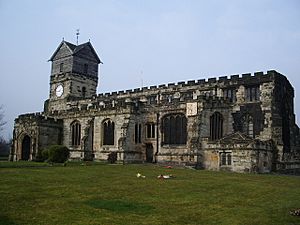 St Leonard's Parish Church, Middleton |
|
| Area | 8.94 sq mi (23.2 km2) |
| Population | 42,972 (2011 Census) |
| • Density | 4,807/sq mi (1,856/km2) |
| OS grid reference | SD875065 |
| • London | 190 miles |
| Metropolitan borough |
|
| Metropolitan county | |
| Region | |
| Country | England |
| Sovereign state | United Kingdom |
| Post town | MANCHESTER |
| Postcode district | M24 |
| Dialling code | 0161 |
| Police | Greater Manchester |
| Fire | Greater Manchester |
| Ambulance | North West |
| EU Parliament | North West England |
| UK Parliament |
|
Middleton is a lively town in Greater Manchester, England. It's located right on the River Irk, about 5 miles (8 km) southwest of Rochdale and 5 miles (8 km) northeast of Manchester. In 2011, about 42,972 people lived here. Middleton sits on the northern edge of Manchester, with areas like Blackley and Moston nearby.
Contents
History of Middleton
Middleton has a long and interesting history. It was once part of Lancashire, a historic county. The town's name comes from its central location, meaning "middle town" among other settlements.
Early Beginnings and Growth
Middleton is thought to have started as a settlement around the 7th century. This was after an Anglo-Saxon king, Æthelfrith of Bernicia, won a battle in 616. Anglo-Saxon settlers followed, and their towns often ended with "ton," like Middleton.
Even though it's not mentioned in the famous Domesday Book from 1086, Middleton is very old. A church likely existed here even before the Norman Conquest of England in 1066. The name "Middleton" first appeared in records in 1194. It comes from the Old English words middel-tūn, meaning "middle farm" or "settlement." This probably refers to its location between Rochdale and Manchester.
During the Middle Ages, people in Middleton made flannel and woollen cloth at home.
Industrial Revolution and Modern Times
Middleton grew a lot during the Industrial Revolution in the 17th and 18th centuries. In 1791, King George III allowed Middleton to have a weekly market and three summer fairs. This helped the town become a busy trading center.
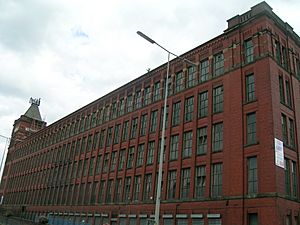
The Industrial Revolution brought large-scale textile making to Middleton. In the 18th century, it was known for silk production. By the mid-1800s, this changed to cotton spinning, making Middleton a true mill town. This industry continued until the mid-20th century.
Middleton was connected to the national railway system until 1964. That's when its local train stations closed for passengers. Now, the closest stations are Mills Hill and Moston.
How Middleton is Governed
Middleton has been part of Lancashire since the early 1100s. It was once an important church area within the hundred of Salford.
Becoming a Borough
In 1861, officials were set up to improve Middleton. By 1886, Middleton officially became a borough, which gave it more local power. Over the years, its boundaries changed a few times, adding nearby areas.
In 1974, the Municipal Borough of Middleton was dissolved. Its area became part of the Metropolitan Borough of Rochdale within Greater Manchester. The local council used to be based at Parkfield House.
Parliamentary Representation
Middleton used to have its own Member of Parliament (MP). Today, it's part of two parliamentary areas: Heywood and Middleton and Blackley and Middleton South. These areas are represented in the House of Commons by MPs from the Labour Party.
Geography of Middleton
Middleton is located on slightly hilly land just north of Manchester. The towns of Chadderton and Royton are to the east, and Rochdale is to the north-northeast. The town center is about 220 feet (67 meters) above sea level.
Climate and Landscape
Like most of the British Isles, Middleton has a temperate maritime climate. This means it has relatively cool summers and mild winters. There's usually light rain throughout the year. Two streams that start nearby flow through Middleton.
Much of Middleton has 19th-century red-brick terraced houses. These were built to support the town's old cotton mills. Since the mid-20th century, new housing areas like Langley, Hollin, and Boarshaw have grown. The St. Leonard's Church stands out in the town's skyline.
Middleton has a mix of busy urban areas, quieter suburbs, and some semi-rural spots. Most of the land is urban. Middleton is connected to other urban areas to its south and east. It's part of the Greater Manchester Urban Area, which is the third largest urban area in the United Kingdom.
The M60 motorway passes south of Middleton, and the M62 passes to the north. A train line runs through the east of Middleton, connecting to Rochdale.
Middleton's Neighborhoods
Middleton includes many different areas and neighborhoods. Some of these are Alkrington, Bowlee, Boarshaw, Cheapside, Greengate, Hebers, Hollin, Hopwood, Jumbo, Langley, Moorclose, Rhodes, Stake Hill, Middleton Junction, Thornham and Tonge. Mills Hill is an area shared with Chadderton.
Middleton's Economy
Middleton is home to several businesses. The Vita Group, which makes industrial polymers, thermoplastics, and nonwovens, has an office here. Kitbag runs a distribution center in Greengate.
Bluebird Bus and Coach and JP Travel (since 1974) are bus companies based in Middleton. Robert McBride, a company that makes household and personal care products, is also in the town.
Famous Landmarks in Middleton
Many of Middleton's buildings were designed by Edgar Wood, a famous architect born in the town. Several of his buildings are important landmarks.
Middleton has recently been redeveloped. A new sports, leisure, and civic center called 'Middleton Arena' was built. A large new Tesco supermarket also opened in the town center in 2013.
In the early 1970s, the Middleton Arndale Centre was built. This modern shopping center opened in 1971 and was officially opened by the Duchess of Kent in 1972.
St. Leonard's Church
The Parish Church of St Leonard was finished in 1524. It includes parts from an older Norman church. People believe an even older wooden Saxon church stood on the site around 1100.
Sir Richard Assheton built the current church. He did this to celebrate being knighted by Henry VIII for his role in the Battle of Flodden in 1513. The Flodden Window inside the church is thought to be the oldest war memorial in the UK. It lists the names of the Middleton archers who fought at Flodden Field. The church also has beautiful monumental brasses, including a rare one of an English Civil War officer in full armor.
The church was named a Grade I listed building in 1957, meaning it's a very important historic building.
Tonge Hall
Tonge Hall is a historic Tudor building. It was badly damaged by a fire in 2007. The local council has been working to restore it. As of 2019, the building still needs repair, surrounded by scaffolding.
Alkrington Hall
Alkrington Hall was built in 1736 and was the home of the Lever family. It sits on a wooded hillside, looking over the Irk Valley towards Middleton. Some of the land around the hall has been used for new houses. The rest is now Alkrington Wood, a Local Nature Reserve.
Old Boar's Head Inn
This old coaching inn is located on Long Street, below the parish church. It was a stop on the road between Chester and York. Parts of the building are thought to date back to the 1500s.
Warwick Mill
Warwick Mill is a former cotton mill built in 1907. It has five floors for machines. It is a Grade II listed building and is currently empty. There have been plans to convert it, but none have happened yet.
Lodge Mill
Lodge Mill is believed to be Middleton's oldest surviving mill. It was built in 1839 and used to be a silk and cotton mill. A fire in 2021 damaged part of the mill. Today, an ice cream shop occupies the front part of the building.
Sports in Middleton
Middleton has many local sports clubs. Middleton Cricket Club plays in the Lancashire League (cricket). There are also four golf clubs nearby: North Manchester Golf Club, The Manchester Golf Club, Heaton Park Golf Club, and Blackley Golf Club.
In 2009, the new £13 million Middleton Arena opened in the town center. This sports and leisure venue replaced the old Civic Centre and Leisure Centre. It was built as a joint project by Rochdale Metropolitan Borough Council and Tesco. A large Tesco Extra supermarket opened on the former site in 2013.
Middleton is also home to Rochdale Triathlon Club. They have swimming sessions at Middleton Arena. Hopwood Hall College also has a gym for students and the public.
Transport in Middleton
In 2005, a new Middleton bus station opened next to the Arndale Centre. This station has 13 stands and cost £4.5 million. Most bus services in Middleton are run by Stagecoach Manchester. They go to places like Bury, Oldham, Rochdale, and Tameside. Middleton is part of the new Bee Network, run by Transport for Greater Manchester (TfGM).
Bus routes include the 17 (Rochdale to Manchester), 18 (Langley to Manchester), 59 (Oldham to Manchester), 125 (Middleton to Heywood), and 163 (Bury to Manchester). Middleton is close to junction 19 of the M62 motorway and junction 21 of the M60 motorway.
Mills Hill railway station is about a mile east of the town center. It has direct trains to Rochdale, Manchester Victoria, Bolton, Wigan, and Leeds. The original Middleton railway station near the town center closed to passengers in 1964.
In 2021, the Mayor of Greater Manchester asked for plans to extend the Metrolink tram system to Middleton.
Education in Middleton
Middleton has many schools, including some with religious connections.
Primary and Secondary Schools
Primary schools include St. Peter's Roman Catholic Primary School, Alkrington Primary School, St. Michael’s CofE Primary School, St. Thomas-More’s Roman Catholic Primary School, and Middleton Parish School.
Secondary schools include Cardinal Langley Roman Catholic High School, Middleton Technology School, the Edgar Wood Academy, and St. Anne's Academy.
Further Education
For further education, students can attend the Sixth Form at Cardinal Langley or the Middleton campus of Hopwood Hall College. This campus was once a Catholic College of Higher Education from 1946 to 1989. Its chapel, designed by Sir Frederick Gibberd, was a model for the Liverpool Metropolitan Cathedral. The chapel is still on campus, but its spire no longer has a cross. Hopwood Hall College has large grounds and leisure facilities.
Famous People from Middleton
People from Middleton are sometimes called "Moonrakers." Many notable people have been born or lived in Middleton.
- Thomas Langley (born 1363) was a very important person. He was a Bishop, a Cardinal in the Catholic Church, and even the Lord Chancellor of England. He was also England's first de facto Foreign Secretary.
- Samuel Bamford was a writer and political activist. He led people from Middleton to a meeting in 1819 to ask for changes in Parliament. This meeting ended in the sad Peterloo Massacre.
- Joel Halliwell (1881–1958) received the Victoria Cross, a very brave award, in World War I.
- Lee Rigby, a British soldier, was from Middleton. He was sadly a victim of an attack in 2013.
Many famous people in entertainment and sports have connections to Middleton:
- Steve Coogan, a well-known actor and comedian.
- John Richmond, a fashion designer.
- Clint Boon from the band Inspiral Carpets.
- Maartin Allcock from Fairport Convention and Jethro Tull.
- Brendan and Martin Coogan.
- All four members of the indie-rock band The Courteeners, including frontman Liam Fray.
- The band The Chameleons, a post-punk group, formed here.
- Sally Dynevor, an actress in the TV show Coronation Street.
- Football players Tommy Booth (Manchester City) and Paul Scholes (Manchester United).
- Cricketer Frank (Typhoon) Tyson.
- Norma Ball, wife of Sir Bobby Charlton.
- Olympic silver medalist Keri-Anne Payne.
See also
 In Spanish: Middleton (Gran Mánchester) para niños
In Spanish: Middleton (Gran Mánchester) para niños


